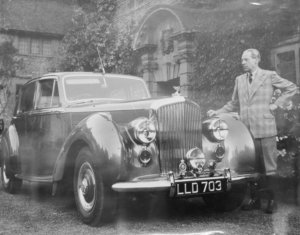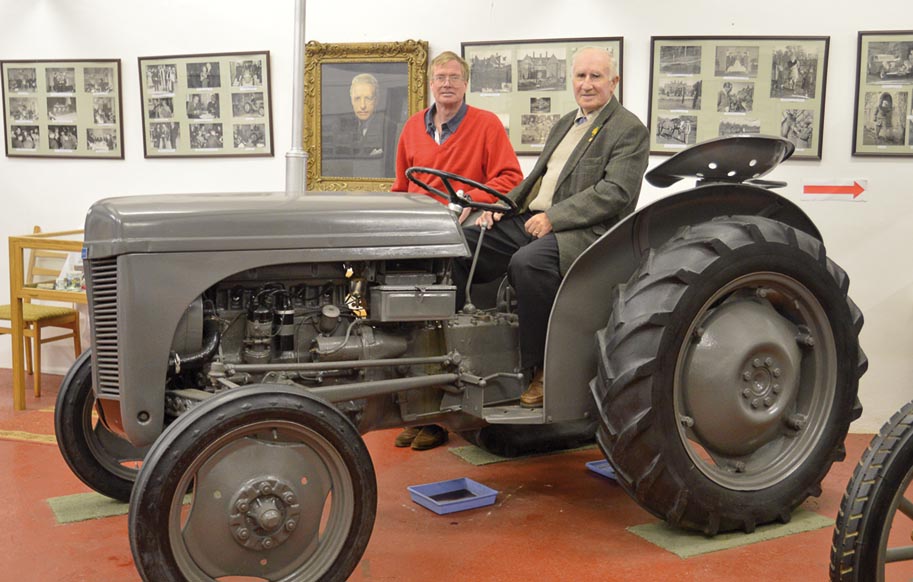 A converted barn tucked discreetly away in West Wight houses a magnificent collection of memorabilia that celebrates the life and achievements of Harry Ferguson.
A converted barn tucked discreetly away in West Wight houses a magnificent collection of memorabilia that celebrates the life and achievements of Harry Ferguson.
Although the name may not initially register with some readers, it was Harry Ferguson whose engineering genius transformed the world of aviation, agriculture and motor racing in Britain and beyond.
The Ferguson Family Museum was opened nearly 10 years ago by Freshwater farmer Jamie Sheldon, the grandson of Harry Ferguson. The collection, which includes tractors, agricultural equipment and a superb array of photographs, was put together by Jamie, with the help of museum curator Peter Warr.
Peter, a sprightly 80-year-old, worked for Ferguson for 10 years until the celebrated inventor and pioneer died in 1960. So it is fitting that Peter, along with Jamie, should have played such a big part in unearthing and displaying such unique and highly treasured works of the early and mid-20th century.
Although Harry Ferguson is perhaps best remembered for inventing the trademark grey tractors that bore his name and became such an integral part of the agricultural industry that is just one chapter in the life of this remarkable man.
He was born in 1888, and in 1909 he became the first man in Britain to build and fly his own airplane. After 50 crashes he finally flew 130 yards, making him a real pioneer in the world of aviation. A quarter-size scale model of the flimsy yet historic plane, which had a first-ever tricycle undercarriage, forms part of the museum collection.
 Ferguson, who lived in Lisburn, Ireland, became a highly skilled mechanic, and his aircraft was built in his brother’s garage in Belfast. He combined that skill with expertly tuning cars, and became heavily involved in motor and motor cycle racing, as well as carrying out consultancy work for the Irish Government on food production, and particularly ploughs.
Ferguson, who lived in Lisburn, Ireland, became a highly skilled mechanic, and his aircraft was built in his brother’s garage in Belfast. He combined that skill with expertly tuning cars, and became heavily involved in motor and motor cycle racing, as well as carrying out consultancy work for the Irish Government on food production, and particularly ploughs.
Jamie said: “My grandfather was involved in many activities, so he was obviously very good at selling himself to people.” Ferguson built his first agricultural plough in 1916, and converted an iconic Ford Model T car to pull it. “So basically the Model T was a tractor that you could take your family to church in,” smiled Jamie.
Recognising that most tractors of that era were big, slow, heavy and dangerous, Ferguson embarked on a mission to design a light, flexible and versatile tractor. In 1925 he invented the prototype of the three-point linkage that ultimately enabled ploughs to become part of the tractor, rather than just be towed precariously behind.
The three-point linkage subsequently became an integral part of every tractor in the world, and Jamie describes the prototype that is on show as the most exciting single item in the museum. But despite trying to market the innovative plough in the United States, few were convinced of its true value. So by 1933 Ferguson had built his own fully functional Black Tractor to integrate the three-point linkage and hydraulics –a massive step forward in agriculture history.
Over the years scores of implements were adapted to fit tractors, and Ferguson tractors were seen on virtually every farm in the country. Then in 1938 there was another major breakthrough when Ferguson met Henry Ford, founder of the Ford Motor Company. The two engineering giants secured a ‘handshake agreement’ for Ford to build ‘Ford Ferguson’ tractors in the US, and for Ferguson to market them.
The agreement ended when Henry Ford died, and the next Ford generation called an abrupt halt. But defiant Ferguson then built a tractor factory in Detroit – right in the heart of Ford car territory – and production began within nine months. In the meantime he supplied tractors to the US from his factory in Coventry, and he eventually won a law suit against the Ford empire for ending the agreement – but only after five years of courtroom haggling.
When Peter Warr began working for Ferguson in 1950, the company had 65 per cent of the world tractor market. And Ferguson’s salesman skills came to the fore on one occasion inside the famous Claridge’s Hotel, London.
 He displayed a tractor inside the hotel, and when one member of the Press doubted its versatility, he promptly pirouetted it on the ballroom, before driving it down the staircase and out of Claridge’s, with onlookers left open-mouthed! The stunt made the front page of ‘The Times’ the following day.
He displayed a tractor inside the hotel, and when one member of the Press doubted its versatility, he promptly pirouetted it on the ballroom, before driving it down the staircase and out of Claridge’s, with onlookers left open-mouthed! The stunt made the front page of ‘The Times’ the following day.
An amalgamation in 1952 saw Ferguson tractors become Massey Ferguson, and a year later Ferguson sold the business to concentrate on his other great passion, motor racing. Incredibly, even in those days he had the vision that cars would be safer with four-wheel drive and anti-skid braking. He teamed up with racing driver and former prisoner of war Tony Rolt to design cars, and in 1954 a prototype with many of the safety features of today’s cars was actually built. No one would manufacture it, probably because in fact it was far ahead of its time!
However, they also built the Ferguson P99 racing car, and although Ferguson died in 1960 his motor racing legacy lived on when his car, driven by Stirling Moss, won the Oulton Park Gold Cup a year later. It was also the only four-wheel drive car ever to win a Grand Prix.
The Ferguson Family Museum provides a fascinating glimpse into days gone by in the fields of aviation, agriculture and motor racing. Not surprisingly enthusiasts flock to the comparatively small but captivating museum, and once inside it is easy to see why.
Visits are by appointment and the museum can also be offered as a venue for meetings for interested clubs or groups. For further information visit website www.ferguson-museum.co.uk or contact Peter Warr or Mandy Miles on 01983 756050.



